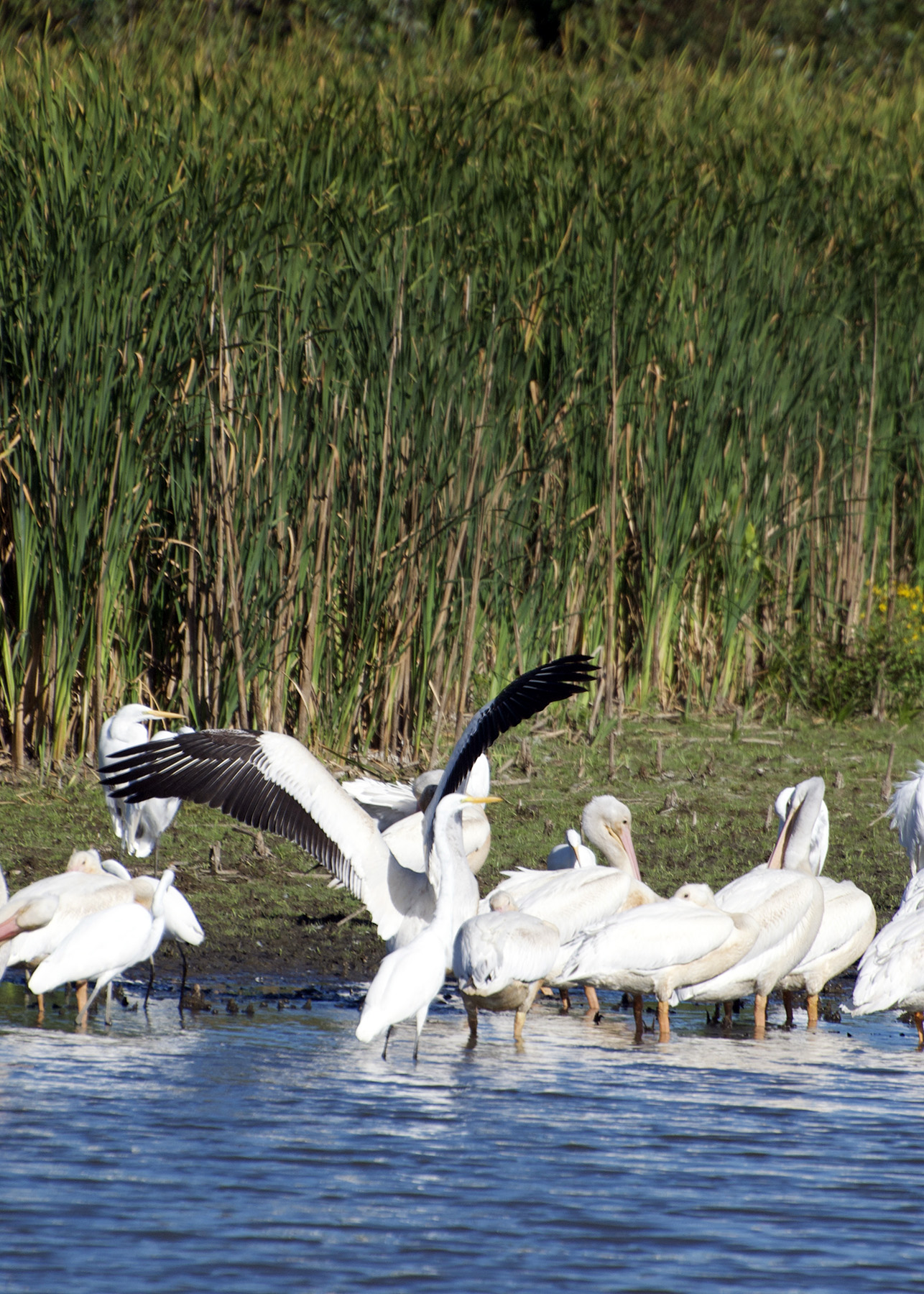I could not believe my eyes. I had stumbled upon a pod of pelicans in Forest Grove, not just in the air on their southwards migration, but actually resting among the unperturbed egrets.

Here they were preening, snoozing, fishing as a fleet. Their large beaks can be adjusted in size not to hold food, as is erroneously presumed, but to serve as a kind of fishing net, which is not exclusively used for fish, by the way. Pelicans do eat smaller birds as well, including pigeons…

Pelicans have played a role in Christian iconography ever since the 3rd century. Some strange story, in a tractate called Physiologus, started to make the rounds: pelican mothers were claimed to kill their rebellious offspring, and then pecking their own breasts to revive them with their blood after three days. Comparisons to salvation history ensued, human kind being punished by G-d for its disobedience, but then the Son redeeming folks with his blood.

The punitive part of the story was eventually dropped, and the redeeming part enhanced. The narrative influenced art throughout the Middle ages, with images of pelicans feeding their chicks as a symbol of G-d’s sacrifice for his flock. The paintings could be found on tabernacles and the top of crosses, as well as frescos of Crucifixion scenes.
“These legends may have arisen because the pelican used to suffer from a disease that left a red mark on its chest. Alternatively it may be that pelicans look as if they are stabbing themselves as they often press their bill into their chest to fully empty their pouch. Yet other possibilities are that they often rest their bills on their breasts, and that the Dalmatian pelican has a blood-red pouch in the early breeding season .” (Ref.)
The point, though, is that rebellion was flagged, punished, and resolved with the pointer to salvation through religious adherence.

Christianity was not the first religion to imbue pelicans with symbolic meaning. In Egypt the birds were thought to be divinity and guide the passage of lost souls through the underworld. However much they were worshipped in those ways, their treatment on earth was not exactly preferential. Pelican populations in this country have been endangered in a variety of ways since the 1880s in competition for fish. “They were clubbed and shot, their eggs and young were deliberately destroyed, and their feeding and nesting sites were degraded by water management schemes and wetland drainage. Even in the 21st century, an increase in the population of American white pelicans in southeastern Idaho in the US was seen to threaten the recreational cutthroat trout fishery there, leading to official attempts to reduce pelican numbers through systematic harassment and culling(Ref.)” Pesticides and oil spills affect them as well, as do hooks of discarded fishing lines.

I hung out with the birds for a while, watching how comfortable they are with each other and how quiet (it is only chicks who vocalize during nesting seasons.) Pelicans are quite social, they have communal courtship rituals, they nest in colonies, they hunt together and they often fish as a fleet.

They eventually took off, single birds rising, then forming groups, circling in formation trying to find the thermals that would lift them to traveling height.




The circles reminded me of another iconography of rebellion, one probably approved by pelicans prone to comradeship. I learned about these solidarity circles which somewhat protected rebels from persecution from comments by Nick Kapur, a Professor of History at Rutgers with a focus on Japan and East Asia.
“In Japan’s Edo Period (1603-1868), when impoverished peasants finally couldn’t take it anymore and decided to revolt, they would sign their list of demands with all their names in a big circle. They had specific reasons for doing this: First, this format expressed their solidarity and commitment to each other, like an endless ring that cannot not be broken.
But perhaps more importantly, the usual way daimyo lords dealt with peasant revolts was torturing and executing the ringleaders but letting everyone else live. After all, they needed peasants to till the fields! By signing in a circle, nobody could tell who the leaders were.”



Apparently, these kinds of circular documents – now known as Round Robins – could also be found in 17th century French petitions to the Crown, in the British Royal Navy when sailors petitioned officers, and in the Spanish American War with demands that embarrassed then President McKinley.

Here’s to pelicans’ unity, robins’ evasiveness, to solidarity and rebels of all kinds! And nature’s endless ability to lift my spirits with surprises.


Music today by an adventurous young artist who is performing Edward Lear’s poem about pelicans (Pelican Chorus) in a Hungarian bath house.







Sara Lee Silberman
What a marvelous posting! In so many particulars!!!!
Steve T.
Great diary, Friderike. I sure need some uplifting; our world seems incredibly tortured by so many elected (!) ‘leaders’. I’m going outside to pretend I see pelicans in my garden.
Dave Schaerer
Friderike – Very much enjoyed your informative post on white pelicans. I’ve come to look forward to the brown pelicans off the Oregon Coast in the summer in search for bait fish while I’m salmon fishing. Have yet to see any magnificent white pelicans there in more than 40+ years of salmon fishing.
Dave Schaerer